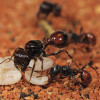You might not feel much like a Californian purple sea urchin, but you're more like one than you might think, according to the latest results from Baylor College of Medicine in Houston. Researchers there have decoded all 814 million letter of DNA in the urchin's genome, revealing more than 23,000 genes. So why are the urchins so interesting? Well they're thought to share a common ancestor with humans. Now I don't mean your granny, but a sea creature that lived around 540 million years ago. This ancestor lead to a group of animals called Deuterostomes - which include humans and all other vertebrates (that's creatures with backbones). The researchers found that sea urchins shared most of the gene families found in humans, although we have more genes in each family. Most intriguingly, sea urchins have genes for sensory proteins that are important for vision and hearing in humans. But the urchins have no eyes or ears, but instead has its sensors in a tube-like appendage. One of the project leaders, Erica Sodergren, says that the sea urchin reminds us of the underlying unity of all life on earth. It's a similar set of genes and proteins being used in different ways by different creatures to create the huge diversity of living forms on our planet.
- Previous Brain Packaging Makes Memories
- Next Good News For Old, Fat Men










Comments
Add a comment